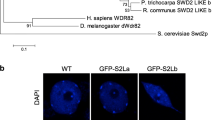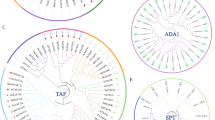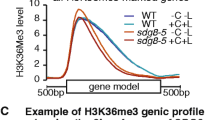Abstract
Although a conserved SAGA complex containing the histone acetyltransferase GCN5 is known to mediate histone acetylation and transcriptional activation in eukaryotes, how to maintain different levels of histone acetylation and transcription at the whole-genome level remains to be determined. Here we identify and characterize a plant-specific GCN5-containing complex, which we term PAGA, in Arabidopsis thaliana and Oryza sativa. In Arabidopsis, the PAGA complex consists of two conserved subunits (GCN5 and ADA2A) and four plant-specific subunits (SPC, ING1, SDRL and EAF6). We find that PAGA and SAGA can independently mediate moderate and high levels of histone acetylation, respectively, thereby promoting transcriptional activation. Moreover, PAGA and SAGA can also repress gene transcription via the antagonistic effect between PAGA and SAGA. Unlike SAGA, which regulates multiple biological processes, PAGA is specifically involved in plant height and branch growth by regulating the transcription of hormone biosynthesis and response related genes. These results reveal how PAGA and SAGA cooperate to regulate histone acetylation, transcription and development. Given that the PAGA mutants show semi-dwarf and increased branching phenotypes without reduction in seed yield, the PAGA mutations could potentially be used for crop improvement.








Similar content being viewed by others
Data availability
A reporting summary for this paper is available as a Supplementary Information file. Raw RNA-seq and ChIP-seq data have been deposited in the Gene Expression Omnibus (GEO) database with the accession code GSE199761. The Arabidopsis and rice sequence data used in this study are from TAIR 10 and the CHINA RICE DATA CENTER, respectively. The accession numbers of genes reported in this study are as follows: GCN5 (AT3G54610), ADA2B (AT4G16420), ADA2A (AT3G07740), SPC (AT1G77800), ING1 (AT3G24010), SDRL (AT1G10310), EAF6 (AT4G14385), SGF29A (AT3G27460), SGF29B (AT5G40550), TAF5 (AT5G25150), TAF6 (AT1G04950), TAF6B (AT1G54360), TAF9 (AT1G54140), TAF10 (AT4G31720), TAF12 (AT3G10070), TAF12B (AT1G17440), SPT20 (AT1G72390), ADA1A (AT2G14850), ADA1B (AT4G33890), ADA1C (AT5G67410), ADA1D (AT4G31440), ADA1E (AT2G24530), TRA1A (AT2G17930), TRA1B (AT4G36080), SF3B3 (AT3G55200, AT3G55220), SF3B5A (AT3G23325), SF3B5B (AT4G14342), SCS1 (AT5G22450), SCS2A (AT2G19390), SCS2B (AT4G29790), TAFL (AT5G65540), HAM1 (AT5G64610), HAM2 (AT5G09740), EPL1A (AT1G16690), EPL1B (AT1G79020), EAF1A (AT3G24880), EAF1B (AT3G24870), ING2 (AT1G54390), SWC4 (AT2G47210), ARP4 (AT1G18450), EAF7 (AT1G26470), GAS41 (AT5G45600), MRG1 (AT4G37280), GA2OX2 (AT1G30040), GA2OX6 (AT1G02400), TCP15 (AT1G69690), IAA19 (AT3G15540), RAV2 (AT1G68840), MYB70 (AT2G23290), OsGCN5 (Os10g0415900), OsADA2 (Os03g0750800), OsSPCA (Os06g0209300), OsING1 (Os03g0143600), OsEAF6B (Os12g0298600), OsSDRL (Os02g0557700), OsTAF5A (Os06g0649500), OsTAF5B (Os07g0205200), OsTAF6 (Os01g0510800), OsTAF9A (Os03g0408500), OsTAF10 (Os09g0431500), OsTAF12B (Os01g0846900), OsSPT20 (Os10g0391100), OsADA1A (Os12g0580500), OsADA1B (Os03g0762700), OsSF3B3A (Os02g0137400), OsSF3B5A (Os08g0444100), OsSCS1A (Os01g0967100), OsSCS2 (Os05g0350700) and OsTAFL (Os03g0802300). Source data are provided with this paper.
References
Kouzarides, T. Chromatin modifications and their function. Cell 128, 693–705 (2007).
Bannister, A. J. & Kouzarides, T. Regulation of chromatin by histone modifications. Cell Res. 21, 381–395 (2011).
Karlic, R., Chung, H. R., Lasserre, J., Vlahovicek, K. & Vingron, M. Histone modification levels are predictive for gene expression. Proc. Natl Acad. Sci. USA 107, 2926–2931 (2010).
Clouaire, T. et al. Comprehensive mapping of histone modifications at DNA double-strand breaks deciphers repair pathway chromatin signatures. Mol. Cell 72, 250–262 (2018).
Kurdistani, S. K., Tavazoie, S. & Grunstein, M. Mapping global histone acetylation patterns to gene expression. Cell 117, 721–733 (2004).
Verdin, E. & Ott, M. 50 years of protein acetylation: from gene regulation to epigenetics, metabolism and beyond. Nat. Rev. Mol. Cell Biol. 16, 258–264 (2015).
Wu, C. J. et al. Three functionally redundant plant-specific paralogs are core subunits of the SAGA histone acetyltransferase complex in Arabidopsis. Mol. Plant 14, 1071–1087 (2021).
Helmlinger, D. & Tora, L. Sharing the SAGA. Trends Biochem. Sci. 42, 850–861 (2017).
Herbst, D. A. et al. Structure of the human SAGA coactivator complex. Nat. Struct. Mol. Biol. 28, 989–996 (2021).
Grant, P. A. et al. Yeast Gcn5 functions in two multisubunit complexes to acetylate nucleosomal histones: characterization of an Ada complex and the SAGA (Spt/Ada) complex. Genes Dev. 11, 1640–1650 (1997).
Spedale, G., Timmers, H. T. & Pijnappel, W. W. ATAC-king the complexity of SAGA during evolution. Genes Dev. 26, 527–541 (2012).
Lee, K. K. et al. Combinatorial depletion analysis to assemble the network architecture of the SAGA and ADA chromatin remodeling complexes. Mol. Syst. Biol. 7, 503–515 (2011).
Wang, L. & Dent, S. Y. Functions of SAGA in development and disease. Epigenomics 6, 329–339 (2014).
Suganuma, T. et al. ATAC is a double histone acetyltransferase complex that stimulates nucleosome sliding. Nat. Struct. Mol. Biol. 15, 364–372 (2008).
Stockinger, E. J., Mao, Y., Regier, M. K., Triezenberg, S. J. & Thomashow, M. F. Transcriptional adaptor and histone acetyltransferase proteins in Arabidopsis and their interactions with CBF1, a transcriptional activator involved in cold-regulated gene expression. Nucleic Acids Res. 29, 1524–1533 (2001).
Earley, K. W., Shook, M. S., Brower-Toland, B., Hicks, L. & Pikaard, C. S. In vitro specificities of Arabidopsis co-activator histone acetyltransferases: implications for histone hyperacetylation in gene activation. Plant J. 52, 615–626 (2007).
Bhat, R. A. et al. Alteration of GCN5 levels in maize reveals dynamic responses to manipulating histone acetylation. Plant J. 33, 455–469 (2003).
Zhou, S. et al. Rice homeodomain protein WOX11 recruits a histone acetyltransferase complex to establish programs of cell proliferation of crown root meristem. Plant Cell 29, 1088–1104 (2017).
Benhamed, M., Bertrand, C., Servet, C. & Zhou, D. X. Arabidopsis GCN5, HD1, and TAF1/HAF2 interact to regulate histone acetylation required for light-responsive gene expression. Plant Cell 18, 2893–2903 (2006).
Chen, C. et al. Cytosolic acetyl-CoA promotes histone acetylation predominantly at H3K27 in Arabidopsis. Nat. Plants 3, 814–824 (2017).
Kim, S. et al. GCN5 modulates salicylic acid homeostasis by regulating H3K14ac levels at the 5’ and 3’ ends of its target genes. Nucleic Acids Res. 48, 5953–5966 (2020).
Servet, C., Conde e Silva, N. & Zhou, D. X. Histone acetyltransferase AtGCN5/HAG1 is a versatile regulator of developmental and inducible gene expression in Arabidopsis. Mol. Plant 3, 670–677 (2010).
Vlachonasios, K. E., Thomashow, M. F. & Triezenberg, S. J. Disruption mutations of ADA2b and GCN5 transcriptional adaptor genes dramatically affect Arabidopsis growth, development, and gene expression. Plant Cell 15, 626–638 (2003).
Kornet, N. & Scheres, B. Members of the GCN5 histone acetyltransferase complex regulate PLETHORA-mediated root stem cell niche maintenance and transit amplifying cell proliferation in Arabidopsis. Plant Cell 21, 1070–1079 (2009).
Poulios, S. & Vlachonasios, K. E. Synergistic action of GCN5 and CLAVATA1 in the regulation of gynoecium development in Arabidopsis thaliana. New Phytol. 220, 593–608 (2018).
Kim, J. Y., Oh, J. E., Noh, Y. S. & Noh, B. Epigenetic control of juvenile-to-adult phase transition by the Arabidopsis SAGA-like complex. Plant J. 83, 537–545 (2015).
Hark, A. T. et al. Two Arabidopsis orthologs of the transcriptional coactivator ADA2 have distinct biological functions. Biochim. Biophys. Acta 1789, 117–124 (2009).
Tan, L. M. et al. The PEAT protein complexes are required for histone deacetylation and heterochromatin silencing. EMBO J. 37, e98770 (2018).
Zhou, J. X. et al. The Arabidopsis NuA4 histone acetyltransferase complex is required for chlorophyll biosynthesis and photosynthesis. J. Integr. Plant Biol. 64, 901–914 (2022).
Zhao, S., Zhang, B., Yang, M., Zhu, J. & Li, H. Systematic profiling of histone readers in Arabidopsis thaliana. Cell Rep. 22, 1090–1102 (2018).
Lee, W. Y., Lee, D., Chung, W. I. & Kwon, C. S. Arabidopsis ING and Alfin1-like protein families localize to the nucleus and bind to H3K4me3/2 via plant homeodomain fingers. Plant J. 58, 511–524 (2009).
Ruiz-Garcia, A. B., Sendra, R., Pamblanco, M. & Tordera, V. Gcn5p is involved in the acetylation of histone H3 in nucleosomes. FEBS Lett. 403, 186–190 (1997).
Hassan, A. H. et al. Function and selectivity of bromodomains in anchoring chromatin-modifying complexes to promoter nucleosomes. Cell 111, 369–379 (2002).
Bian, C. et al. Sgf29 binds histone H3K4me2/3 and is required for SAGA complex recruitment and histone H3 acetylation. EMBO J. 30, 2829–2842 (2011).
Hedden, P. The genes of the Green Revolution. Trends Genet. 19, 5–9 (2003).
Wang, B., Smith, S. M. & Li, J. Genetic regulation of shoot architecture. Annu. Rev. Plant Biol. 69, 437–468 (2018).
Wang, Y. & Li, J. Molecular basis of plant architecture. Annu. Rev. Plant Biol. 59, 253–279 (2008).
Rieu, I. et al. Genetic analysis reveals that C19-GA 2-oxidation is a major gibberellin inactivation pathway in Arabidopsis. Plant Cell 20, 2420–2436 (2008).
Wang, H., Caruso, L. V., Downie, A. B. & Perry, S. E. The embryo MADS domain protein AGAMOUS-Like 15 directly regulates expression of a gene encoding an enzyme involved in gibberellin metabolism. Plant Cell 16, 1206–1219 (2004).
Davière, J. M. et al. Class I TCP-DELLA interactions in inflorescence shoot apex determine plant height. Curr. Biol. 24, 1923–1928 (2014).
Marzi, D. et al. Light controls stamen elongation via cryptochromes, phytochromes and COP1 through HY5 and HYH. Plant J. 103, 379–394 (2020).
Matías-Hernández, L. et al. TEMPRANILLO reveals the mesophyll as crucial for epidermal trichome formation. Plant Physiol. 170, 1624–1639 (2016).
Wan, J. et al. MYB70 modulates seed germination and root system development in Arabidopsis. iScience 24, 103228 (2021).
Li, S. & Shogren-Knaak, M. A. The Gcn5 bromodomain of the SAGA complex facilitates cooperative and cross-tail acetylation of nucleosomes. J. Biol. Chem. 284, 9411–9417 (2009).
Ringel, A. E., Cieniewicz, A. M., Taverna, S. D. & Wolberger, C. Nucleosome competition reveals processive acetylation by the SAGA HAT module. Proc. Natl Acad. Sci. USA 112, E5461–E5470 (2015).
Vermeulen, M. et al. Quantitative interaction proteomics and genome-wide profiling of epigenetic histone marks and their readers. Cell 142, 967–980 (2010).
Guo, J. et al. The CBP/p300 histone acetyltransferases function as plant-specific MEDIATOR subunits in Arabidopsis. J. Integr. Plant Biol. 63, 755–771 (2020).
Kim, D., Paggi, J. M., Park, C., Bennett, C. & Salzberg, S. L. Graph-based genome alignment and genotyping with HISAT2 and HISAT-genotype. Nat. Biotechnol. 37, 907–915 (2019).
Liao, Y., Smyth, G. K. & Shi, W. featureCounts: an efficient general purpose program for assigning sequence reads to genomic features. Bioinformatics 30, 923–930 (2014).
Robinson, M. D., McCarthy, D. J. & Smyth, G. K. edgeR: a Bioconductor package for differential expression analysis of digital gene expression data. Bioinformatics 26, 139–140 (2010).
Zhao, Q. Q., Lin, R. N., Li, L., Chen, S. & He, X. J. A methylated-DNA-binding complex required for plant development mediates transcriptional activation of promoter methylated genes. J. Integr. Plant Biol. 61, 120–139 (2019).
Langmead, B. & Salzberg, S. L. Fast gapped-read alignment with Bowtie 2. Nat. Methods 9, 357–359 (2012).
Zang, C. et al. A clustering approach for identification of enriched domains from histone modification ChIP-seq data. Bioinformatics 25, 1952–1958 (2009).
Zhang, Y. et al. Model-based analysis of ChIP-seq (MACS). Genome Biol. 9, R137 (2008).
Chen, L. Q. et al. ATX3, ATX4, and ATX5 encode putative H3K4 methyltransferases and are critical for plant development. Plant Physiol. 174, 1795–1806 (2017).
Acknowledgements
This work was supported by the National Natural Science Foundation of China (32025003) to X.-J.H.
Author information
Authors and Affiliations
Contributions
C.-J.W., Z.-Z.L., X.X., L.W., L.L. and S.C. performed the experiments. D.-Y.Y., X.-W.C. and Y.-N.S. performed the bioinformatics analyses. C.-J.W. and X.-J.H. designed the experiments and wrote the manuscript.
Corresponding author
Ethics declarations
Competing interests
The authors declare no competing interests.
Peer review
Peer review information
Nature Plants thanks Keqiang Wu and the other, anonymous, reviewer(s) for their contribution to the peer review of this work.
Additional information
Publisher’s note Springer Nature remains neutral with regard to jurisdictional claims in published maps and institutional affiliations.
Extended data
Extended Data Fig. 1 PAGA-dependent regulation of gene expression as determined by RNA-seq.
a, Scatter plots showing the correlation of gene expression changes between the spc mutant and the other PAGA mutants or the ada2b mutant. P values were generated by two-sided Pearson correlation test. b, Venn diagrams showing the overlap of down- and up-regulated DEGs (log2 FC > 1 or < −1, FDR < 0.05) in spc, spc ing1, and ada2a spc. P values were determined by the hypergeometric test (one-tailed). c, Heatmap showing the correlation of the effects of PAGA mutants on gene expression. Values indicate correlation coefficients.
Extended Data Fig. 2 Genome browser view of enriched signals of the ADA2B-, GCN5-, ADA2A-, and ING1-GFP proteins detected by ChIP-seq.
Screenshot showing some regions where both SAGA and PAGA are recruited and regions where only either SAGA or PAGA are recruited. Red boxes indicate SAGA- and PAGA-shared peaks. Pink boxes indicate SAGA-specific peaks. Green boxes indicate PAGA-specific peaks.
Extended Data Fig. 3 Identification of H3K9Ac and H3K14Ac level by ChIP-seq.
a, Genome browser view of H3K9Ac- and H3K14Ac-enriched peaks in WT detected by ChIP-seq. b, Percentage of genes with reduced (FC < 0.9, FDR < 0.01), increased (FC > 1.1, FDR < 0.01), and unchanged H3K14Ac levels in gcn5, ada2b, ada2a, and spc ing1 among the GCN5-, ADA2B-, ADA2A-, and ING1-bound genes, respectively. Values are the number of genes. c, Venn diagrams showing the overlap of ADA2B-, GCN5-, ADA2A-, and ING1-bound genes with reduced H3K14Ac level in ada2b, gcn5, ada2a, and spc ing1, respectively. d, Venn diagrams showing the overlap of H3K9Ac- and H3K14Ac-reduced target genes in ada2b, gcn5, ada2a, and spc ing1, respectively. e, Venn diagrams showing the overlap of H3K9Ac-reduced genes (FC < 0.9, FDR < 0.05) and expression-reduced genes (log2 FC < −1, FDR < 0.05) in gcn5, ada2b, ada2a, and spc ing1. P values were determined by the hypergeometric test (one-tailed).
Extended Data Fig. 4 H3K9Ac and H3K4me3 levels of SAGA- and PAGA-bound genes.
a, Boxplots showing the H3K9Ac and H3K4me3 levels of total SAGA- and PAGA-bound genes and bound genes with reduced or increased/unchanged H3K9Ac level in the corresponding SAGA and PAGA mutants. Random: 5000 random genes. Sample size of each boxplot: GCN5-bound a (n = 10081), b (n = 4717), and c (n = 5364); ADA2B-bound a (n = 6033), b (n = 3035), and c (n = 2998); ADA2A-bound a (n = 6940), b (n = 2234), and c (n = 4706); and ING1-bound a (n = 12989), b (n = 3095), c (n = 9894). In boxplots, centre lines and box edges are medians and the interquartile range (IQR), respectively. Whiskers extend within 1.5 times the IQR. P values determined by two-tailed Mann Whitney U test are indicated above boxes. b, H3K9Ac and H3K4me3 levels of SAGA- and PAGA-bound genes and of the bound genes with affected levels of H3K9Ac in the corresponding mutants. Total Arabidopsis genes were divided into deciles based on the H3K9Ac and H3K4me3 levels and sorted in ascending order. In each decile, the number of total ADA2B-, GCN5-, ADA2A-, and ING1-bound genes and of the bound genes with increased, reduced, and unchanged levels of H3K9Ac in the corresponding mutants are shown.
Extended Data Fig. 5 Morphological phenotypes of the SAGA and PAGA mutant plants.
a, Morphological phenotypes of the SAGA and PAGA mutant plants at different developmental stages. The top, middle, and bottom panels show 12-, 20-, and 31-day-old plants, respectively. b, The top panel shows images of trichomes on the adaxial side of the first leaf of WT, SAGA and PAGA mutant seedlings. Images are of 12-day-old seedlings grown on MS medium. The bottom panel shows morphological phenotypes of inflorescences in the SAGA and PAGA mutants. c, Left, shown are root length of 12-day-old seedlings (n = 20), numbers of the first rosette leaf with abaxial trichomes (n = 10), and numbers of rosette leaves from bolting plants (n = 24). ND indicates that ada2b mutant plants lacked trichomes on the abaxial side of rosette leaves. Right, shown are trichome numbers per leaf, leaf area, and trichome density on the adaxial side of the first leaf in the WT, SAGA and PAGA mutant seedlings (n = 10) (grown for 12 days on MS medium). Values are mean ± s.d. P values determined by two-tailed Student’s t-test are indicated above columns.
Extended Data Fig. 6 PAGA and SAGA antagonistically regulate plant development.
a, Morphological phenotypes of 30-day-old WT and T-DNA insertion mutant plants. b, Fresh weight of 30-day-old WT and T-DNA insertion mutant plants (n = 10). Values are mean ± s.d. P values determined by two-tailed Student’s t-test are indicated above columns.
Extended Data Fig. 7 Transcript levels of AT2G23290, AT2G17230, and AT1G70090 genes.
Transcript levels of indicated genes as determined RT-PCR. Values are means ± s.d. of three independent biological replicates. P values determined by two-tailed Student’s t-test are indicated above columns.
Supplementary information
Supplementary Information
Supplementary Figs. 1–15 and Tables 1 and 2.
Supplementary Data 1
Full list of co-purified proteins as determined by AP–MS using transgenic Arabidopsis plants in the WT and in the indicated mutant backgrounds.
Supplementary Data 2
Full list of co-purified proteins as determined by AP–MS using OsGCN5-GFP, OsADA2-GFP, OsSPCA-GFP and OsING1-GFP transgenic rice plants in the WT background.
Supplementary Data 3
Differentially expressed genes in the 12-day-old gcn5, ada2b, ada2a, spc, ing1, sdrl, eaf6, ada2a spc and spc ing1 mutants as determined by RNA-seq.
Supplementary Data 4
Peaks enriched by GCN5, ADA2B, ADA2A and ING1 as determined by ChIP-seq.
Supplementary Data 5
Peaks with reduced and increased H3K9Ac levels in the gcn5, ada2b, ada2a and spc ing1 mutants as determined by ChIP-seq.
Supplementary Data 6
Peaks with reduced and increased H3K14Ac levels in the gcn5, ada2b, ada2a and spc ing1 mutants as determined by ChIP-seq.
Supplementary Data 7
Differentially expressed genes in the 30-day-old gcn5, ada2b-c, ada2a, spc, ada2b-c ada2a and ada2b-c spc mutants as determined by RNA-seq.
Supplementary Data 8
List of primers used in this study.
Source data
Source Data Fig. 2
Unprocessed western blots.
Source Data Fig. 3
Unprocessed western blots.
Rights and permissions
Springer Nature or its licensor (e.g. a society or other partner) holds exclusive rights to this article under a publishing agreement with the author(s) or other rightsholder(s); author self-archiving of the accepted manuscript version of this article is solely governed by the terms of such publishing agreement and applicable law.
About this article
Cite this article
Wu, CJ., Yuan, DY., Liu, ZZ. et al. Conserved and plant-specific histone acetyltransferase complexes cooperate to regulate gene transcription and plant development. Nat. Plants 9, 442–459 (2023). https://doi.org/10.1038/s41477-023-01359-3
Received:
Accepted:
Published:
Issue Date:
DOI: https://doi.org/10.1038/s41477-023-01359-3
- Springer Nature Limited
This article is cited by
-
Exploring the Composition and Catalytic Specificity of Sorghum Histone Acetyltransferase Complexes
Plant Molecular Biology Reporter (2023)





